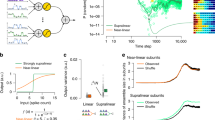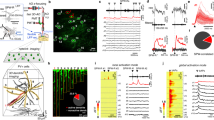Abstract
Dendritic spikes signal synaptic integration at remote apical dendritic sites in neocortical pyramidal neurons in vitro. Do dendritic spikes have a salient signaling role under in vivo conditions, where neocortical pyramidal neurons are bombarded with synaptic input? In the present study, levels of synaptic conductance apparent during active network states in vivo were emulated in vitro. Pronounced enhancement of somatic or apical dendritic conductance was spatially compartmentalized and 'visible' over a dendritic length (∼200 μm) on the order of half the voltage length constant, as predicted by passive cable models. The spatial compartmentalization of conductance allowed independent subthreshold synaptic integration at axo-somatic and apical dendritic sites. Furthermore, spikes generated at distal apical dendritic sites efficiently propagated to the axon to initiate action potentials under high synaptic conductance states. The dendritic arborization and voltage-activated channel complement of rat neocortical pyramidal neurons are therefore optimized to allow distributed processing under realistic conductance states.
This is a preview of subscription content, access via your institution
Access options
Subscribe to this journal
Receive 12 print issues and online access
$209.00 per year
only $17.42 per issue
Buy this article
- Purchase on Springer Link
- Instant access to full article PDF
Prices may be subject to local taxes which are calculated during checkout






Similar content being viewed by others
References
Coombs, J.S., Curtis, D.R. & Eccles, J.C. The interpretation of spike potentials of motoneurones. J. Physiol. (Lond.) 139, 198–231 (1957).
Stuart, G., Spruston, N., Sakmann, B. & Häusser, M. Action potential initiation and backpropagation in neurons of the mammalian CNS. Trends Neurosci. 20, 125–131. (1997).
Rall, W. Theoretical significance of dendritic trees for neuronal input-output relations. in Neural Theory and Modeling (ed. Reiss, R.F.) 73–97 (Stanford Univ. Press, Palo–Alto, 1964).
Williams, S.R. & Stuart, G.J. Dependence of EPSP efficacy on synapse location in neocortical pyramidal neurons. Science 295, 1907–1910 (2002).
Stuart, G. & Spruston, N. Determinants of voltage attenuation in neocortical pyramidal neuron dendrites. J. Neurosci. 18, 3501–3510 (1998).
Berger, T., Larkum, M.E. & Luscher, H.R. High I(h) channel density in the distal apical dendrite of layer V pyramidal cells increases bidirectional attenuation of EPSPs. J. Neurophysiol. 85, 855–868 (2001).
Williams, S.R. & Stuart, G.J. Site independence of EPSP time course is mediated by dendritic Ih in neocortical pyramidal neurons. J. Neurophysiol. 83, 3177–3182 (2000).
Pare, D., Shink, E., Gaudreau, H., Destexhe, A. & Lang, E.J. Impact of spontaneous synaptic activity on the resting properties of cat neocortical pyramidal neurons In vivo. J. Neurophysiol. 79, 1450–1460 (1998).
Destexhe, A., Rudolph, M. & Pare, D. The high-conductance state of neocortical neurons in vivo. Nat. Rev. Neurosci. 4, 739–751 (2003).
Borg-Graham, L.J., Monier, C. & Fregnac, Y. Visual input evokes transient and strong shunting inhibition in visual cortical neurons. Nature 393, 369–373 (1998).
Bernander, O., Douglas, R.J., Martin, K.A. & Koch, C. Synaptic background activity influences spatiotemporal integration in single pyramidal cells. Proc. Natl. Acad. Sci. USA 88, 11569–11573 (1991).
Rudolph, M. & Destexhe, A. A fast-conducting, stochastic integrative mode for neocortical neurons in vivo. J. Neurosci. 23, 2466–2476 (2003).
London, M. & Segev, I. Synaptic scaling in vitro and in vivo. Nat. Neurosci. 4, 853–855 (2001).
Häusser, M., Spruston, N. & Stuart, G.J. Diversity and dynamics of dendritic signaling. Science 290, 739–744 (2000).
Williams, S.R. & Stuart, G.J. Voltage- and site-dependent control of the somatic impact of dendritic IPSPs. J. Neurosci. 23, 7358–7367 (2003).
Kim, H.G. & Connors, B.W. Apical dendrites of the neocortex: correlation between sodium- and calcium-dependent spiking and pyramidal cell morphology. J. Neurosci. 13, 5301–5311 (1993).
Schiller, J., Major, G., Koester, H.J. & Schiller, Y. NMDA spikes in basal dendrites of cortical pyramidal neurons. Nature 404, 285–289 (2000).
Larkum, M.E., Zhu, J.J. & Sakmann, B. Dendritic mechanisms underlying the coupling of the dendritic with the axonal action potential initiation zone of adult rat layer 5 pyramidal neurons. J. Physiol. (Lond.) 533, 447–466 (2001).
Larkum, M.E. & Zhu, J.J. Signaling of layer 1 and whisker-evoked Ca2+ and Na+ action potentials in distal and terminal dendrites of rat neocortical pyramidal neurons in vitro and in vivo. J. Neurosci. 22, 6991–7005 (2002).
Golding, N.L. & Spruston, N. Dendritic sodium spikes are variable triggers of axonal action potentials in hippocampal CA1 pyramidal neurons. Neuron 21, 1189–1200 (1998).
Golding, N.L., Staff, N.P. & Spruston, N. Dendritic spikes as a mechanism for cooperative long-term potentiation. Nature 418, 326–331 (2002).
Ariav, G., Polsky, A. & Schiller, J. Submillisecond precision of the input-output transformation function mediated by fast sodium dendritic spikes in basal dendrites of CA1 pyramidal neurons. J. Neurosci. 23, 7750–7758 (2003).
Zhu, J.J. Maturation of layer 5 neocortical pyramidal neurons: amplifying salient layer 1 and layer 4 inputs by Ca2+ action potentials in adult rat tuft dendrites. J. Physiol. (Lond.) 526, 571–587 (2000).
Rhodes, P.A. & Llinas, R.R. Apical tuft input efficacy in layer 5 pyramidal cells from rat visual cortex. J. Physiol. (Lond.) 536, 167–187 (2001).
Mel, B.W. Synaptic integration in an excitable dendritic tree. J. Neurophysiol. 70, 1086–1101 (1993).
Häusser, M. & Mel, B. Dendrites: bug or feature? Curr. Opin. Neurobiol. 13, 372–383 (2003).
Poirazi, P., Brannon, T. & Mel, B.W. Pyramidal neuron as two-layer neural network. Neuron 37, 989–999 (2003).
Williams, S.R. & Stuart, G.J. Role of dendritic synapse location in the control of action potential output. Trends Neurosci. 26, 147–154 (2003).
Rall, W. Distinguishing theoretical synaptic potentials computed for different soma-dendritic distributions of synaptic input. J. Neurophysiol. 30, 1138–1168 (1967).
Koch, C., Douglas, R. & Wehmeier, U. Visibility of synaptically induced conductance changes: theory and simulations of anatomically characterized cortical pyramidal cells. J. Neurosci. 10, 1728–1744 (1990).
Harsch, A. & Robinson, H.P. Postsynaptic variability of firing in rat cortical neurons: the roles of input synchronization and synaptic NMDA receptor conductance. J. Neurosci. 20, 6181–6192 (2000).
Shu, Y., Hasenstaub, A. & McCormick, D.A. Turning on and off recurrent balanced cortical activity. Nature 423, 288–293 (2003).
Chance, F.S., Abbott, L.F. & Reyes, A.D. Gain modulation from background synaptic input. Neuron 35, 773–782 (2002).
Wehr, M. & Zador, A.M. Balanced inhibition underlies tuning and sharpens spike timing in auditory cortex. Nature 426, 442–446 (2003).
Magee, J.C. & Johnston, D. A synaptically controlled, associative signal for Hebbian plasticity in hippocampal neurons. Science 275, 209–213 (1997).
Tsubokawa, H. & Ross, W.N. IPSPs modulate spike backpropagation and associated [Ca2+]i changes in the dendrites of hippocampal CA1 pyramidal neurons. J. Neurophysiol. 76, 2896–2906 (1996).
Larkum, M.E., Zhu, J.J. & Sakmann, B. A new cellular mechanism for coupling inputs arriving at different cortical layers. Nature 398, 338–341 (1999).
Stuart, G.J. & Häusser, M. Dendritic coincidence detection of EPSPs and action potentials. Nat. Neurosci. 4, 63–71 (2001).
Larkman, A.U. Dendritic morphology of pyramidal neurones of the visual cortex of the rat: I. Branching patterns. J. Comp. Neurol. 306, 307–319 (1991).
Colbert, C.M., Magee, J.C., Hoffman, D.A. & Johnston, D. Slow recovery from inactivation of Na+ channels underlies the activity-dependent attenuation of dendritic action potentials in hippocampal CA1 pyramidal neurons. J. Neurosci. 17, 6512–6521 (1997).
Schaefer, A.T., Larkum, M.E., Sakmann, B. & Roth, A. Coincidence detection in pyramidal neurons is tuned by their dendritic branching pattern. J. Neurophysiol. 89, 3143–3154 (2003).
Koch, C., Rapp, M. & Segev, I. A brief history of time (constants). Cereb. Cortex 6, 93–101 (1996).
Salin, P.A. & Bullier, J. Corticocortical connections in the visual system: structure and function. Physiol. Rev. 75, 107–154 (1995).
Cauller, L.J., Clancy, B. & Connors, B.W. Backward cortical projections to primary somatosensory cortex in rats extend long horizontal axons in layer I. J. Comp. Neurol. 390, 297–310 (1998).
Waters, J., Larkum, M., Sakmann, B. & Helmchen, F. Supralinear Ca2+ influx into dendritic tufts of layer 2/3 neocortical pyramidal neurons in vitro and in vivo. J. Neurosci. 23, 8558–8567 (2003).
Rapp, M., Yarom, Y. & Segev, I. Modeling back propagating action potential in weakly excitable dendrites of neocortical pyramidal cells. Proc. Natl. Acad. Sci. USA 93, 11985–11990 (1996).
Acknowledgements
I am grateful to S. Atkinson, L. Gentet, B. Khakh and L. Lagnado for helpful comments on the manuscript.
Author information
Authors and Affiliations
Corresponding author
Ethics declarations
Competing interests
The author declares no competing financial interests.
Supplementary information
Supplementary Fig. 1
Control of apical dendritic spikes. (a) Quadruple somato-dendritic recording of dendritic spikes evoked by a threshold current step (green) under control (upper traces) and in the presence of a somatic conductance source (90 nS). (b) In conductance-insensitive neurons (n = 29) incremental increases of somatic conductance failed to alter the amplitude of dendritic spikes at site of generation (red), at proximal apical dendritic loci (blue) or the initiation of axonal action potentials (black). (c) In a conductance-sensitive neuron enhanced somatic conductance (90 nS) broke the link between dendritic spike generation and axonal action potential initiation. (d) Pooled data demonstrating the independence of dendritic spike generation, but the conductance-dependent disruption of axonal action potential firing (n = 16) in conductance-sensitive neurons. (GIF 34 kb)
Supplementary Fig. 2
Properties of conductance-sensitive and conductance-insensitive neurons. (a) In conductance-sensitive and -insensitive neurons enhanced somatic conductance (90 nS) decreased the somatic peak apparent input resistance to a similar degree. (b) Distribution of the maximal rate of rise of dendritic spikes recorded at distal (right data cluster) and proximal apical dendritic sites. (c) Pooled analysis describing the maximal rate of rise of dendritic spikes and somatic action potentials in the two classes of neurons (conductance-insensitive: site of generation 25.6 ± 2.1 Vs−1 (567 ± 13 μm), proximal-apical 68.0 ± 6.5 Vs−1 (250 ± 9 μm), soma 381.6 ± 9.1 Vs−1; conductance-sensitive: site of generation 17.7 ± 2.0 Vs−1, P < 0.005 (Students' T-test) (587 ± 17 μm), proximal-apical 34.3 ± 4.9 Vs−1, P < 0.001 (225 ± 12 μm), soma 370.1 ± 11.7 Vs−1 (not different)). (GIF 28 kb)
Rights and permissions
About this article
Cite this article
Williams, S. Spatial compartmentalization and functional impact of conductance in pyramidal neurons. Nat Neurosci 7, 961–967 (2004). https://doi.org/10.1038/nn1305
Received:
Accepted:
Published:
Issue Date:
DOI: https://doi.org/10.1038/nn1305
This article is cited by
-
Auditory input enhances somatosensory encoding and tactile goal-directed behavior
Nature Communications (2021)
-
Differential chloride homeostasis in the spinal dorsal horn locally shapes synaptic metaplasticity and modality-specific sensitization
Nature Communications (2020)
-
Illuminating dendritic function with computational models
Nature Reviews Neuroscience (2020)
-
Type-specific dendritic integration in mouse retinal ganglion cells
Nature Communications (2020)
-
Cognitive self-management requires the phenomenal registration of intrinsic state properties
Philosophical Studies (2020)



